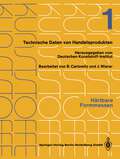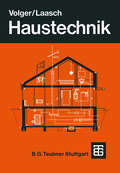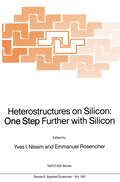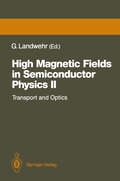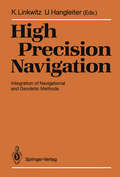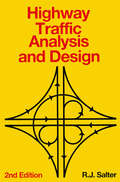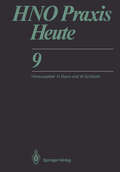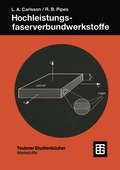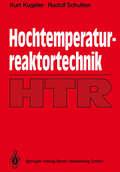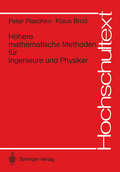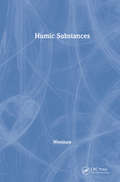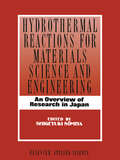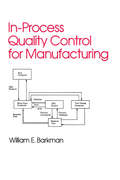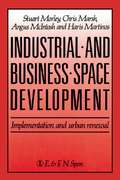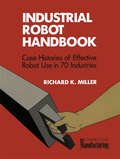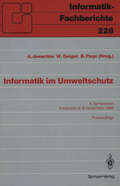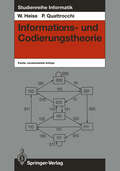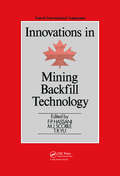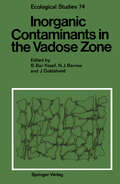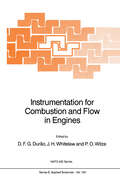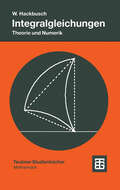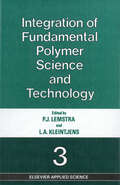- Table View
- List View
Härtbare Formmassen: Merkblätter 1–400 (Kunststoffe #1-2 / 1)
by Bodo Carlowitz Jutta WiererPflichtfortsetzung KunststoffeTechnik - Daten - Kompaktwissen 6000 Produkte. Eine Vielzahl physikalisch-technischer Daten. Niemand kann sie alle kennen. Aber jeder sollte wissen, wo er sich detailliert darüber informieren kann, was für ihn wichtig ist - für neue Projekte, aktuelle Entscheidungen, alltägliche Arbeitsabläufe. Kunststoffedas Loseblattwerk aus dem Springer-Verlag verschafft Herstellern, Verarbeitern und Händlern den kompetenten Überblick über die Handelsprodukte. Gleichzeitig erleichtert es die individuelle Auswahl der für ihre Probleme geeigneten Handelsprodukte. Kunststoffebasiert auf einer anerkannt kompetenten Quelle: Es ist ein Auszug aus der Datenbank "Polymat" des Deutschen Kunststoff-Institutes (DKI) in Darmstadt. KunststoffeDas Werk ist in 3 Teile gegliedert: - Thermoplaste - Härtbare Formmassen - Gießharze.Jeder Teil wird in mehreren Ordnern geliefert, je nachdem, wieviele Merkblätter zu der Produktgruppe gehören. Die ersten 716 Merkblätter des 2. Teils "Härtbare Formmassen" liegen nun in 2 Bänden vor, wobei der 2. Band auch das Register enthält. Im Verlaufe der Zeit werden weitere Produkte auf Merkblättern dargestellt und der 2. Band auf 400 Merkblättern aufgefüllt und weitere Bände anglegt. Neben einer Erläuterung der Auswahlkriterien von Verarbeitungsdaten wird in die Benutzung der Merkblätter eingeführt. Die Register bieten einen Zugang über die Hersteller bzw. Anbieter und die Kunststoffart. Außerdem wird die Merkblatt-Nummer mit der Dokumentnummer der Datenbank Polymat des DKI verknüpft. Pflichtfortsetzung: Entweder Bezug des kompletten Werkes "Kunststoffe" oder eines kompletten Themenbereiches (z.B. Härtbare Formmassen)
Heterostructures on Silicon: One Step Further with Silicon (NATO Science Series E: #160)
by Y. Nissim Emmanuel RosencherIn the field of logic circuits in microelectronics, the leadership of silicon is now strongly established due to the achievement of its technology. Near unity yield of one million transistor chips on very large wafers (6 inches today, 8 inches tomorrow) are currently accomplished in industry. The superiority of silicon over other material can be summarized as follow: - The Si/Si0 interface is the most perfect passivating interface ever 2 obtained (less than 10" e y-I cm2 interface state density) - Silicon has a large thermal conductivity so that large crystals can be pulled. - Silicon is a hard material so that large wafers can be handled safely. - Silicon is thermally stable up to 1100°C so that numerous metallurgical operations (oxydation, diffusion, annealing ... ) can be achieved safely. - There is profusion of silicon on earth so that the base silicon wafer is cheap. Unfortunatly, there are fundamental limits that cannot be overcome in silicon due to material properties: laser action, infra-red detection, high mobility for instance. The development of new technologies of deposition and growth has opened new possibilities for silicon based structures. The well known properties of silicon can now be extended and properly used in mixed structures for areas such as opto-electronics, high-speed devices. This has been pioneered by the integration of a GaAs light emitting diode on a silicon based structure by an MIT group in 1985.
High Magnetic Fields in Semiconductor Physics II: Transport and Optics, Proceedings of the International Conference, Würzburg, Fed. Rep. of Germany, August 22–26, 1988 (Springer Series in Solid-State Sciences #87)
by Gottfried LandwehrThis volume contains contributions presented at the International Conference "The Application of High Magnetic Fields in Semiconductor Physics", which was held at the University of Wiirzburg from August 22 to 26, 1988. In the tradition of previous Wiirzburg meetings on the subject - the first conference was held in 1972 - only invited papers were presented orally. All 42 lecturers were asked to review their subject to some extent so that this book gives a good overview of the present state of the respective topic. A look at the contents shows that the subjects which have been treated at previous conferences have not lost their relevance. On the contrary, the application of high magnetic fields to semiconductors has grown substantially during the recent past. For the elucidation of the electronic band structure of semicon ductors high magnetic fields are still an indispensable tool. The investigation of two-dimensional electronic systems especially is frequently connected with the use of high magnetic fields. The reason for this is that a high B-field adds angular momentum quantization to the boundary quantization present in het erostructures and superlattices. A glance at the contributions shows that the majority deal with 2D properties. Special emphasis was on the integral and fractional quantum Hall effect. Very recent results related to the observation of a fraction with an even denbminator were presented. It became obvious that the polarization of the different fractional Landau levels is more complicated than originally anticipated.
High Precision Navigation: Integration of Navigational and Geodetic Methods
by Klaus Linkwitz Ulrich HangleiterThe book is based on an international workshop on High Precision Navigation. The reader will find a wealth of information on - satellite navigation systems and their geodetic applications, especially using GPS - laser and radar techniques - image processing and image sequence analysis - autonomous vehicle guidance systems - inertial navigation systems - integration of different sensor systems.
Highway Traffic Analysis and Design
by R.J. SalterA guide to analyzing and predicting traffic. It also covers the various problems encountered when designing traffic signal controls and highways to accommodate the varying volume.
HNO Praxis Heute (HNO Praxis heute #9)
by W. Behrendt E. Biesinger K. Fleischer H. Ganz I. Görisch M. Moser F. W. Oeken W. Schätzle O. Staindl H. J. Wilhelm G. WolfDie jährlich erscheinende Reihe bietet eine praxisbezogene Fort- und Weiterbildung speziell für den niedergelassenen HNO-Arzt und den Klinikassistenten. Die Themen werden so gewählt, daß in regelmäßigem Turnus alle für die HNO-Praxis wichtigen Bereiche je nach Aktualität abgehandelt werden. Der HNO-Arzt kann sich mit dieser Reihe eine komprimierte und ständig aktuelle Bibliothek der praktischen Hals-Nasen-Ohren-Heilkunde aufbauen, die ihm modernes Fachwissen und das nötige "know-how" vermittelt. Die entzündlichen Komplikationen der Otitis media haben im Antibiotikazeitalter einen Gestaltwandel erfahren. Fehldiagnosen vermeiden zu helfen ist das Ziel des ersten Beitrages. Von den Verletzungen im Gesichtsbereich sind die lateralen Frakturen (Jochbein, Jochbogen, blow out) ebenso häufig wie therapeutisch denkbar. Unterschiedliche Gesichtspunkte bei der operativen Versorgung müssen berücksichtigt bzw. koordiniert werden. Die Tonsillitiden sowie die Crux chronische Pharyngitis mit deren Differentialdiagnose gehören zur täglichen Praxis. Inwieweit spielt die chronische Laryngitis eine Rolle bei der Entstehung des Larynxkarzinoms, und wie behandelt man Präkanzerosen im Kehlkopf? Fragen, die immer wieder diskutiert werden. Wie versorgt man Narben im Gesicht? Dieses Problem stellt sich auch jedem niedergelassenen Arzt. Der Beitrag informiert über die vielfältigen Möglichkeiten. Die fundierte Darstellung des Problems Barotraumen wird dem Leser ebenso empfohlen wie die systematische und praxisorientierte Beschreibung der Auswirkungen funktioneller Störungen der Halswirbelsäule mit ihren HNO-Symptomen.
Hochleistungsfaserverbundwerkstoffe: Herstellung und experimentelle Charakterisierung (Teubner Studienbücher Mechanik)
by Leif A. Carlsson R. Byron PipesHochtemperaturreaktortechnik
by Kurt Kugeler Rudolf SchultenDas Konzept des Hochtemperaturreaktors (HTR) zeichnet sich durch "inhärente Sicherheit" aus; weitere Vorzüge liegen darin, daß bereits kleinere Einheiten wirtschaftlich betrieben werden und nicht nur zur Stromerzeugung, sondern auch in der Wärme- und Verfahrenstechnik eingesetzt werden können. Damit ist der HTR als Alternative zu den bisher favorisierten Reaktorlinien in das öffentliche Interesse getreten. Das Buch vermittelt nicht nur technische Fakten, sondern erläutert die physikalischen und technischen Prinzipien zum Verständnis der Funktion und stellt die notwendigen Grundlagen für die Auslegung des Kugelhaufenreaktors zur Verfügung. Die Komponenten werden ausführlich beschrieben. Ein Schwerpunkt liegt auf der Diskussion der Sicherheitseigenschaften bzw. des Störfallverhaltens; ebenso werden die Konzepte zur Brennstoffversorgung bzw. -entsorgung vorgestellt. Einsatzmöglichkeiten des HTR werden ebenso wie Bewertungsverfahren für den wirtschaftlichen Betrieb aufgezeigt.
Höhere mathematische Methoden für Ingenieure und Physiker (Hochschultext)
by Peter Plaschko Klaus BrodDas Buch führt mathematische Methoden zur Berechnung der Lösungen von Differentialgleichungen vor. Einen Schwerpunkt dabei bilden Näherungsverfahren. Im Unterschied zu rein mathematischen Lehrbüchern, die oft mit hohem Abstraktionsgrad arbeiten und der strengen Beweisführung häufig viel Raum widmen, geht das vorliegende Buch ausführlich auf Anwendungen und Methoden ein, die in der Praxis besonders wichtig sind. Ein abschließendes Kapitel behandelt das aktuelle Thema deterministisch-chaotischer Systeme. Die Autoren wenden sich an Studenten im Hauptstudium sowie an in der Forschung arbeitende Ingenieure und Physiker, aber auch an andere Naturwissenschaftler, die sich mit Lösungsproblemen komplizierter Differntialgleichungen beschäftigen.
Humic Substances
by Robert L. Wershaw Michael A. MikitaThis book is an introduction and guide to the use of nuclear magnetic resonance (NMR) spectroscopy for the study of humic materials and coals. It provides a general discussion of the application of liquid-state and solid-state NMR techniques.
Humic Substances
by Robert L. Wershaw Michael A. MikitaThis book is an introduction and guide to the use of nuclear magnetic resonance (NMR) spectroscopy for the study of humic materials and coals. It provides a general discussion of the application of liquid-state and solid-state NMR techniques.
Hydrothermal Reactions for Materials Science and Engineering: An Overview of Research in Japan
by S. SomiyaAccording to the late Professor Emeritus Seitaro Tsuboi,l the word 'hydrothermal' was used as early as 1849 by a British geologist, Sir Roderick Murchison (1792-187 I), in relation to the action of heated water in bringing about change in the earth's crust. The term abounds in later geological literature, and is most frequently met in connection with the processes that take place at a stage near the closing in the course of consolidation of magma. When a cooling magma reaches that stage, the residual liquid contains a large proportion of volatile components, chiefly water, and further cooling results in the formation of minerals of special interest or ore-deposits. A great concern of Tsuboi's as a petrologist was to elucidate the details of the nature of various actions involved in these 'hydrothermal processes', of which little was known. It is remarkable that, in the last few decades, extensive high-temperature and high-pressure experiments, in which water plays an important role, have become practicable in laboratories, owing to the development of new apparatus and new methods. As a result, the knowledge essential to the elucidation of 'hydrothermal processes' has been improved, but is still far from complete.
In-Process Quality Control for Manufacturing
by William BarkmanThis book provides a common sense computer-oriented, determinstic manufacturing approach, which employs statistics but does not require a background in this area, theoretical mathematics or computer science to understand and apply. In a clear, easy-to-read style, this reference text highlights critical parameters that have a major impact upon process quality and identifies sensors for parameter monitoring; discusses appropriate applications of deterministic techniques to many manifacturing situations ranging from simple to complex; includes chapter summaries, helpful illustrations and numerous citations to ehnance comprehension and facilitate further research. Written from the perspective of a practioner who 'knows how to make parts'; presenting practical solutions to manufacturing problems it is essential reading for industrial, quality control, electrical and electronics, mechancial, manufacturing and systems engineers/managers and undergraduate and graduate-level students in the above areas.
Industrial and Business Space Development: Implementation and urban renewal
by C. Marsh H. Martinos A. McIntosh S. MorelyAn insight into the changing nature of the industrial and business space property market and how business space development schemes can be initiated and implemented to revitalise urban areas.
Industrial and Business Space Development: Implementation and urban renewal
by C. Marsh H. Martinos A. McIntosh S. MorelyAn insight into the changing nature of the industrial and business space property market and how business space development schemes can be initiated and implemented to revitalise urban areas.
Industrial Robot Handbook (VNR Competitive Manufacturing Series)
by Richard K. MillerThese are exciting times for manufacturing engineers. It has been said that American industry will undergo greater changes during the 1980 and 1990 decades than it did during the entire eight preceding decades of this century. The industrial robot has become the symbol of this progress in computer-integrated manufacturing. This book is for engineers and managers in manufacturing industries who are involved in implementing robotics in their operations. With tens of thousands of industrial robots already in use in the United States, there are plenty of role models for proposed applications to be patterned after. This book provides an overview of robot applications and presents case histories that might suggest applications to engineers and managers for implementation in their own facilities. The application of industrial robots were well developed in the late 1970s and early 1980s. While the reader may note some of the examples discussed in this handbook incorporate older robot models, it is the application that is of interest. As Joseph Engelberger, the founding father of robotics has pointed out, industrial robots in 1988 are "doing pretty much the same kind of work" as they did in 1980.
Informatik im Umweltschutz: 4. Symposium Karlsruhe, 6.–8. November 1989 Proceedings (Informatik-Fachberichte #228)
by Andreas Jaeschke Werner Geiger Bernd PageDieser Tagungsband des vierten Symposiums "Informatik im Umweltschutz" (Karlsruhe, 6.-8. November 1989) behandelt den Einsatz von Informatikmethoden in allen Bereichen des Umweltschutzes: Luft, Klima, Wasser, Abfall, Altlasten, Boden, Naturraum, Raumplanung, Pflanzen, Wald, Tiere. Die Problematik wird sowohl praktisch anhand konkreter Projekte als auch methodisch anhand grundlegender Prinzipien und Verfahren dargestellt. Die Beiträge zeigen den derzeitigen Stand von Entwicklungen und Projekten und diskutieren anstehende Probleme und Lösungen. Sie geben damit einen Überblick über die in diesem neuen Anwendungsgebiet gestellten Anforderungen an die Informatik und die zukünftig notwendigen methodischen Entwicklungen. Der Tagungsband wendet sich an alle Wissenschaftler, Ingenieure aus Forschung, Industrie und Behörden, die mit Umweltschutz befaßt sind.
Informations- und Codierungstheorie: Mathematische Grundlagen der Daten-Kompression und -Sicherung in diskreten Kommunikationssystemen (Studienreihe Informatik)
by Werner Heise Pasquale QuattrocchiInnovations in Mining Backfill Technology
by F. P. Hassani M. J. Scoble T. R. YuProceedings of the 4th International Symposium held in Montreal, Oct.2-5, 1989. Paper topics include: review, laboratory testing, modelling and design, rockburst control, soft rock mining, and system design.
Innovations in Mining Backfill Technology
by F.P.HASSANI; M.J.SCOBLE; T.R.YUProceedings of the 4th International Symposium held in Montreal, Oct.2-5, 1989. Paper topics include: review, laboratory testing, modelling and design, rockburst control, soft rock mining, and system design.
Inorganic Contaminants in the Vadose Zone (Ecological Studies #74)
by Bnayahu Bar-Yosef N. J. Barrow J. GoldshmidThe understanding of pollutant transformations, sorption and transport in soils and uptake by plants is the key to controlling contaminant movement towards groundwater and accumulation in food-chains. Some of these major processes were discussed in the first International Workshop on Pollutants in Porous Media, con vened in Israel in 1983 (pollutants in Porous Media, Eds. Yaron, Dagan and Goldshmid, Springer-Verlag, 1984). Since that meeting, research on contaminant impact on the environment expanded considerably. New mechanisms explaining inorganic pollutant par titioning between solid and solution phases in soils were proposed and tested; specific elements and specific reactions were investigat ed, and more case studies to evaluate management practice effects on drinking water quality and accumulation of contaminants in crops were carried out. The recognition that the new knowledge needs to be discussed and evaluated, and the scientific and engineering communities be updated, led the IUPAC (Interna tional Union of Pure and Applied Chemistry) and IAHS (Interna tional Association of Hydrological Sciences) Water Quality Com missions to organize a second International Workshop on pollu tant behaviour in the vadose zone, hosted by the Institute of Soils and Water of the Agricultural Research Organization, Israel. In this workshop, taking place in June 1987, attention was focused on chemical, physico-chemical and microbial-mediated reactions of different contaminants in the vadose zone. This book contains selected works presented in the 1987 workshop by invited special ists from various disciplines and countries.
Instrumentation for Combustion and Flow in Engines (NATO Science Series E: #154)
by D. F. G. Durão J. H. Whitelaw P. O. WitzeMuch has been said and written about the abilities of modern instrumentation to help solve problems of combustion in engines. In the main, however, the design and fabr ication of combustion chambers continues to be based on extrapolation of exper ience gained from use and rig tests, with little input from advanced techniques such as those based on optical diagnotics. At the same time, it has become increasingly difficult to design better combustion chambers without knowledge of the relevant flow processes. Thus, the future must involve improved understanding which, in turn, will require detailed measurements of velocity, temperature and concentration. The need to narrow the gap between current industrial practice and the acquisition and implementation of improved techniques motivated the organization of the Advanced Study Institute upon which this volume is based. This Institute on Instrumentation for Combustion and Flow in Engines was arranged to display the needs of industry and the possibilities made available by modern instrumentation and, at the same time, to make clear the relative advantages of optical and probe techniques. Held at Vimeiro during the period from 13 to 26 September, 1987, the Institute was attended by 120 participants and 16 invited lecturers.
Integralgleichungen: Theorie und Numerik (Leitfäden der angewandten Mathematik und Mechanik - Teubner Studienbücher #68)
by Wolfgang HackbuschDie Integralgleichungen stellen ein Gebiet dar. das für sich durchaus selbständig ist und auf einer interessanten Mischung von Analysis. Funktionentheorie und Funktionalanalysis beruht. Auf der anderen Seite gewinnen die Integralgleichungen ihr praktisches Interesse aus der «Integralgleichungsmethode». die es erlaubt, partielle Differential gleichungen in Integralgleichungen umzuformen. Das Buch ist aus Vorlesungen hervorgegangen, die der Autor an der Ruhr-Universität Bochum und der Christian-Albrechts-Universität Kiel gehalten hat. Der Umfang der Kapitel 1 bis 6 entspricht etwa einer intensiven vierstündigen Vorlesung. Das Studium der Integral gleichungen kann mit Vorkenntnissen der Analysis und den Grundlagen der Numerik aufgenommen werden. Kenntnisse aus der Funktional analysis sind hilfreich. aber nicht unabdingbar, wenn Grundbegriffe wie Banach-und Hilbert-Räume geläufig sind. Der Theorieteil dieses Buches ist so knapp wie möglich bemessen. da die Numerik in den Kapiteln 2. 4, 5 im Vordergrund stehen soll. Wichtige Teile der benötigten Funktionalanalysis wie etwa die Riesz-Schauder-Theorie werden ohne Herleitung wiedergegeben. Es wird dabei davon ausgegangen. daß dem Leser dieses Gebiet entweder aus einer Vorlesung über «Funktionalanalysis» bekannt ist oder daß e- mit gesteigerter Motivation durch praktische Beispiele - diese Kapitel durch Vorlesungen oder Lektüre nachholen wird. Es sei daran erinnert. daß auch historisch die Funktionalanalysis aus der Diskussion der Integralgleichungen hervorgegangen ist. Als Funktionenräume werden in dieser Darstellung vornehmlich die klassischen der stetigen oder Hölder-stetigen Funktionen verwendet. Die Sobolev-Räume werden weitgehend vermieden. was zum Beispiel zur Folge hat. daß die Integraloperatoren hier nicht in der erforderlichen Allgemeinheit als Pseudodifferentialoperatoren diskutiert werden können.
Integration of Fundamental Polymer Science and Technology—3
by P. J. Lemstra L. A. KleintjensThe Rolduc Polymer Meetings, of which the contents of this volume represent the third, are already on their way to occupying a unique place in the crowded calendar of symposia on every aspect of polymer science and engineering. They combine manageable meeting size with a theme, 'Integration of Fundamental Polymer Science and Technology', which is often discussed but seldom realized in practice. The technological, or applied, areas of polymers have perhaps received more emphasis historically than those of other allied disciplines. Indeed, various plastic and rubber materials were successful items of commerce long before the macromolecular concept itself was firmly established. The more fundamental aspects of the field were also largely developed in industrial laboratories. The early work of Mark and Meyer at IG Farben, and that of Carrothers and Flory at Du Pont, are good examples of this. The present situation, in which polymers are being applied to more and more demanding end uses, from high performance materials on the one hand to the biomedical and electronics fields on the other, caIls for an ever greater understanding of the basic scientific principles governing their behavior. It is evident, therefore, that interactions between those engaged in the 'pure' and 'applied' parts of the field must be promoted effectively. The Rolduc Polymer Meetings contribute significantly to such interactions, not only by interweaving technological and scientific presentations, but also by providing a forum for the participants to discuss problems of mutual interest in all their complexity.
